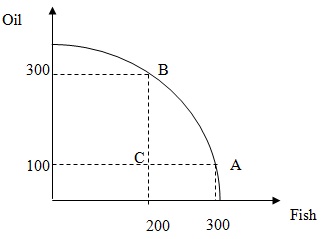I. Multiple Choices:
The country of Myland can use its resources to produce either Oil or Fish according to the PPF in the picture below (numbers represent pounds):

Problem 1) Assume that Myland is producing at point A. What is the opportunity cost, measured in pounds of fish, of moving to point B?
- 200 pounds of fish.
- 0 pounds of fish.
- 100 pound of fish.
- 2 pounds of fish.
Problem 2) Now assume that Myland is producing at point C. In this case, what is the opportunity cost, measured in pounds of fish, of moving to point B?
- 200 pounds of fish.
- 0 pounds of fish.
- 100 pounds of fish.
- 2 pounds of fish.
Problem 3) Which of the following statements is NOT TRUE about the employment of resources in the country of Myland?:
- Producing at point C is inefficient.
- Producing at either point A or B is efficient.
- At point A, Myland is employing all of its available resources.
- At any point on and below the PPF, Myland is employing all of its available resources.
Problem 4) What is most likely to happen if the country of Myland experiences growth in its labor force?
- If producing at point A, it will move along the PPF to point B.
- The PPF of this country will change.
- If producing at point C, it will move to point B.
- None of the above.
Problem 5) John can grow in his backyard either potatoes or salad. The opportunity cost of growing salad is constant at any quantity of potatoes and salad produced. Then we can say that the PPF of John's backyard has a:
- Bowed in toward the origin shape.
- Bowed out from the origin shape.
- Linear shape (constant slope).
- All of the above are possible.
Answer the next three questions using the following information.
You and your friend need to go to the library. You have to make some photocopies and look for some books. It takes you 5 minutes to photocopy 10 pages and 10 minutes to look for a book. It takes your friend 10 minutes to photocopy 10 pages and 12 minutes to look for a book.
Problem 6) Which of the following is TRUE?
- You have the absolute advantage in making photocopies and your friend in looking for books.
- For your friend, the opportunity cost of looking for 1 book is photocopying 20 pages.
- For you, the opportunity cost of making 10 photocopies is looking for 1 book.
- You have the comparative advantage in making photocopies.
Problem 7) If you both specialize according to your comparative advantage:
- You will make the photocopies and look for the books.
- You will make photocopies and your friend will look for the books.
- Your friend will make photocopies and look for the books.
- You will look for the books while your friend makes photocopies.
Problem 8) Assume that you have to photocopy 60 pages each and each look for 3 books. How much time can you gain if you specialize according to the respective comparative advantages (assume that you do not help each other when done with your own task)?
- 12 minutes.
- 24 minutes.
- 36 minutes.
- There is no gain from specialization.
II. Problems:
Problem 1) Amy and Jenna are roommates. After a dinner with their friends, they need to clean their apartment and to do the dishes (unfortunately, they do not have either a dishwasher or a vacuum cleaner). They both have 2 hours available to complete their tasks. In 1 hour, Amy can either do 1/2 of the dishes or clean 1/3 of the house. On the other hand, in 1 hour Jenna can either do 3/4 of the dishes or clean 1/4 of the house.
- Who has the absolute advantage in doing the dishes?
- Who has the absolute advantage in cleaning the house?
- Compute the opportunity cost of doing all the dishes for both Amy and Jenna.
- Compute the opportunity cost of cleaning the whole house for both Amy and Jenna.
- Who has the comparative advantage in what?
Problem 2) Jim and Tony like to grow tomatoes and onions in their backyard. In one month, Jim can grow in his backyard either 60 tomatoes and 0 onions or 0 tomatoes and 30 onions or any other combination lying on the line between these two points. In the same amount of time, Tony can grow in his backyard either 40 tomatoes and 0 onions or 0 tomatoes and 10 onions or any other combination lying on the line between these two points.
a. Assuming that there is no trade in vegetables between Jim and Tony, what is the price of 1 onion in terms of tomatoes for Jim?
b. Assuming that there is no trade in vegetables between Jim and Tony, what is the price of 1 onion in terms of tomatoes for Tony?
c. Who has the comparative advantage in the production of what?
d. If they start trading with each other, who will sell what?
e. How much will they be willing to offer/accept for any transaction in onions and tomatoes?